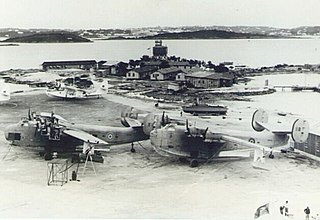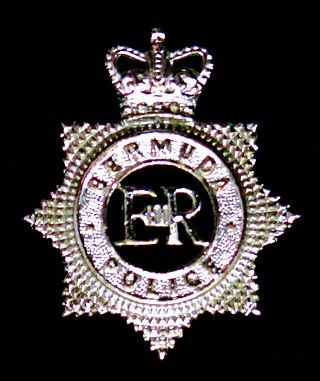
Bermuda is a British Overseas Territory in the North Atlantic Ocean. The closest land outside the territory is in the American state of North Carolina, about 1,035 km (643 mi) to the west-northwest.

While the defence of Bermuda remains the responsibility of the government of the United Kingdom, rather than of the local Bermudian Government, the island still maintains a militia for the purpose of defence.

L.F. Wade International Airport, formerly named Bermuda International Airport, is the sole airport serving the British overseas territory of Bermuda in the north Atlantic Ocean. It is located in the parish of St. George's and is 6 nautical miles northeast of Bermuda's capital, Hamilton. In 2016, the airport handled 402,925 passengers, up 5.6% from 2006. It has one passenger terminal, one cargo terminal, eight aircraft stands and can support all aircraft sizes up to and including the Airbus A380. Currently, nine passenger or cargo airlines operate seasonal or year-round scheduled services from the Azores, Canada, the United Kingdom, and the United States. The airport covers 536 acres of land and contains one runway.

The destroyers-for-bases deal was an agreement between the United States and the United Kingdom on September 2, 1940, according to which 50 Caldwell, Wickes, and Clemson-class US Navy destroyers were transferred to the Royal Navy from the US Navy in exchange for land rights on British possessions.

Kindley Air Force Base was a United States Air Force base in Bermuda from 1948–1970, having been operated from 1943 to 1948 by the United States Army Air Forces as Kindley Field.

A naval air station is a military air base, and consists of a permanent land-based operations locations for the military aviation division of the relevant branch of a navy. These bases are typically populated by squadrons, groups or wings, their various support commands, and other tenant commands.

United States border preclearance is the United States Department of Homeland Security's (DHS) practice of operating prescreening border control facilities at airports and other ports of departure located outside of the United States pursuant to agreements between the United States and host countries. Travelers are subject to immigration and customs inspections by Customs and Border Protection (CBP) officers before boarding their transportation onward to the United States. Preclearance applies to all passengers regardless of their nationality or purpose of travel. Upon arrival, precleared passengers arrive in the United States as domestic travelers, but may still be subject to re-inspection at the discretion of CBP. This process is intended to streamline border procedures, reduce congestion at American ports of entry, and facilitate travel into airports that otherwise lack immigration and customs processing facilities for commercial flights.

The Portuguese Air Force is the aerial warfare force of Portugal. Locally it is referred to by the acronym FAP but internationally is often referred to by the acronym PRTAF. It is the youngest of the three branches of the Portuguese Armed Forces.

The Royal Air Force (RAF) operated from two locations in the Imperial fortress colony of Bermuda during the Second World War. Bermuda's location had made it an important naval station since US independence, and, with the advent of the aeroplane, had made it as important to trans-Atlantic aviation in the decades before the Jet Age. The limited, hilly land mass had prevented the construction of an airfield, but, with most large airliners in the 1930s being flying boats, this was not initially a limitation.

The Bermuda Police Service is the law enforcement agency of the British Overseas Territory and former Imperial fortress of Bermuda. It is responsible for policing the entire archipelago, including incorporated municipalities, and the surrounding waters. It is part of, and entirely funded by, the Government of Bermuda. Like the Royal Bermuda Regiment, it is under the nominal control of the territory's Governor and Commander in Chief, although, for day-to-day purposes, control is delegated to a minister of the local government. It was created in 1879, as Bermuda's first professional police service. In organisation, operation, and dress, it was created and has developed in line with the patterns established by British Isles police services, such as the City of Glasgow Police, and the Metropolitan Police Service.

Naval Air Station Bermuda, was located on St. David's Island in the British Colony of Bermuda from 1970 to 1995, on the former site of Kindley Air Force Base. It is currently the site of Bermuda International Airport.

Airport police units are a security police agency assigned to perform law enforcement functions at airports. They provide a wide range of law enforcement duties and responsibilities including patrol, investigation, traffic flow management, and control and response to airport emergencies. Airport police provide enhanced safety to airport employees, and to passengers. Officers can be found at security gates, throughout the terminal area, and around the airport’s perimeter.

Admiral Sir Charles Edward Kennedy-Purvis was a Royal Navy officer who went on to be Deputy First Sea Lord.

The United States Naval Station Whites Island was a United States Navy (USN) facility located on White's Island in Hamilton Harbour, in the British Colony of Bermuda, 640 miles off the coast of North Carolina.

The Bermuda Base Command was a command of the United States Army, established to defend the British Colony of Bermuda, located 640 miles off Cape Hatteras, North Carolina. It was created in April 1941 when United States Army troops were sent to the island.

773 Naval Air Squadron was a Naval Air Squadron of the Royal Navy's Fleet Air Arm which was last active between September 1950 and March 1951. 773 Naval Air Squadron initially formed during June 1940, as a Fleet Requirements Unit in Bermuda, in support of ships on the North America and West Indies Station. It performed this role four almost four years and eventually disbanded, at Bermuda, in April 1944. The squadron reformed during June 1945 as a Service Trials Unit, at HMS Daedalus, RNAS Lee-on-Solent. Tasked with investigating pilotless aircraft as targets, it was known as the Pilotless Aircraft Unit (PAU). It moved to HMS Goldcrest II, RNAS Brawdy where it disbanded in September 1946. The squadron reformed at the start of 1949 as a Fleet Requirements Unit, out of 771 Naval Air Squadron, lasting around three months and repeated this at the start of 1950 and again at the end of 1950, into 1951.

HMS Castle Harbour was a civilian harbour vessel of 730 tons that was taken-up from trade (TUFT) during the Second World War by the Royal Naval Dockyard in Bermuda for use by the Royal Naval Examination Service and later armed and commissioned as a warship, providing harbour defence from submarines.

Lord Salisbury described Malta, Gibraltar, Bermuda, and Halifax as Imperial fortresses at the 1887 Colonial Conference, though by that point they had been so designated for decades. Later historians have also given the title "imperial fortress" to St. Helena and Mauritius.

RNAS Bermuda was a Royal Naval Air Station in the Royal Naval Dockyard on Ireland Island until 1939, then Boaz Island, Bermuda. Bermuda became the primary base for the North America and West Indies Station of the Royal Navy in the North-West Atlantic following American independence. It was the location of a dockyard, an Admiralty House, and the base of a naval squadron.





















